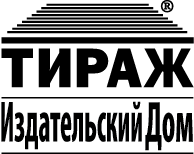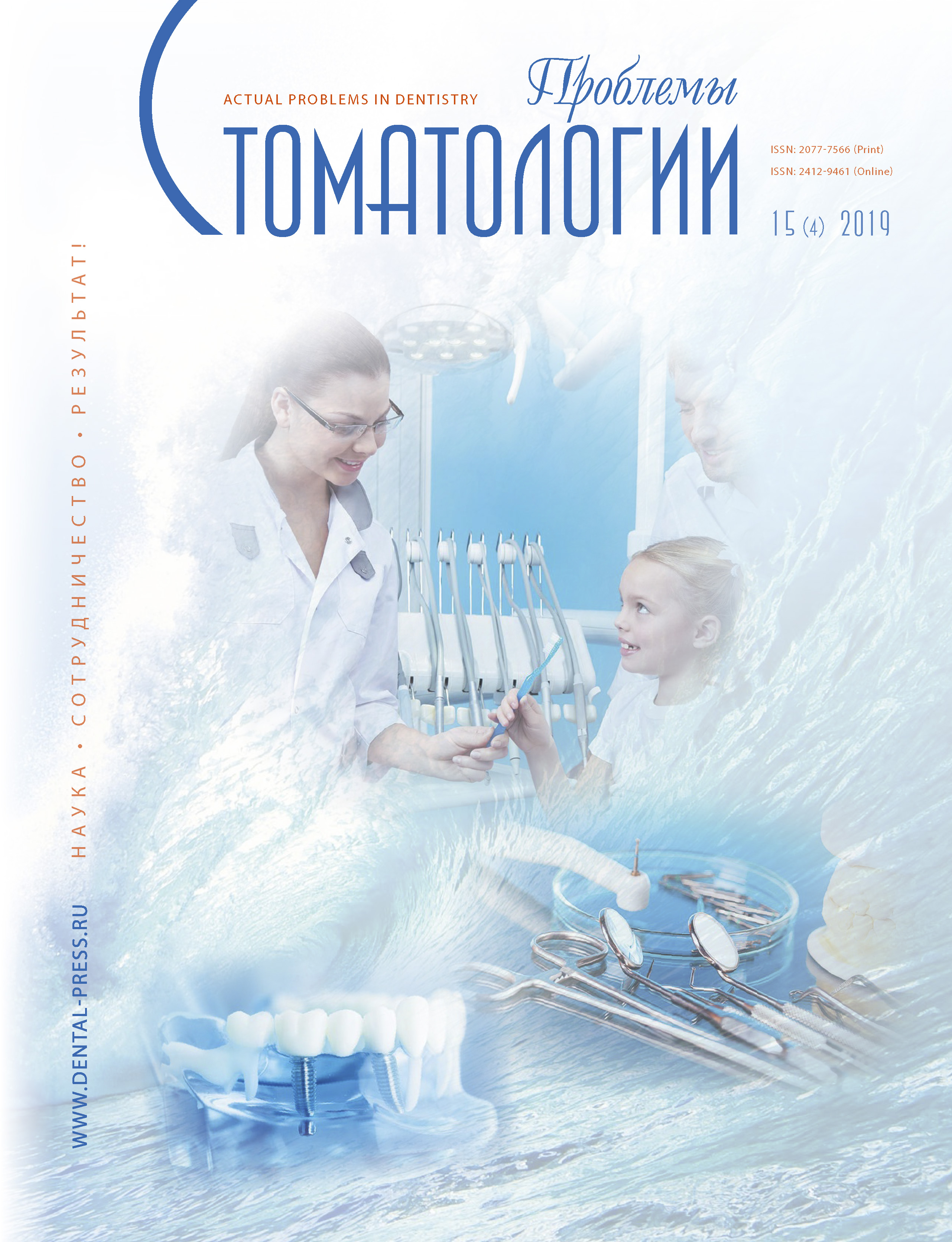Perm', Perm, Russian Federation
Perm, Russian Federation
from 01.01.2015 until now
FGBOU VO PGMU im. akademika E.A. Vagnera Minzdrava Rossii
Perm', Russian Federation
from 01.01.2017 to 01.01.2020
Perm', Perm, Russian Federation
UDC 61
CSCSTI 76.09
CSCSTI 76.29
Russian Classification of Professions by Education 31.08.75
Russian Library and Bibliographic Classification 566
BISAC MED003040 Allied Health Services / Medical Technology
BISAC MED016070 Dentistry / Prosthodontics
Subject: The paper deals with measured biomedical characteristics of samples of a prosthodontic thermoplastic polymer, in regards to certain potentially pathogenic species of oral microflora. Evaluation and comparative analysis of С. albicans adhesion and colonization activity on the prosthodontic material surface were undertaken. Materials and methods: The research used the following reference strains: C. albicans, S. aureus, S. epidermidis and Escherichia coli. The biofilms were visualized by means of a plate reader, PowerWave X (USA) after staining with 0.1% aqueous solution of gentian violet and alcohol extraction of the dye. The bacteria were tested for viability by direct inoculation of selective media. Results: С. albicans was found to produce a more prominent film on the thermoplastic polymer than other potentially pathogenic microorganisms. Conclusions: Satisfactory biomedical characteristics of the thermoplastic material allow it to be used for prosthodontic purposes.
thermoplastic materials, biofilm, Staphylococcus aureus, Staphylococcus epidermidis, Escherichia coli, Candida albicans, microbial biofilms, yeast fungi, oral bacteria, removable dentures, polymers
1. Antsiferov, V. N., Rogozhnikov, G. I., Kislykh, F. I., Astashina, N. B., Smetkin, A. A., Rapekta, S. I. (2009). Primeneniye sovremennykh konstruktsionnykh materialov pri kompleksnom lechenii bol'nykh s defektami chelyustno-litsevoy oblasti [The use of modern construction materials in the complex treatment of patients with maxillofacial defects areas]. Perspektivnyye materialy [Promising materials], 3, 46-51. (in Russ.)
2. Arutyunov, S. D., Tsarev, V. N., Ippolitov, E. V., Apresyan, S. V., Trefilov, A. G. (2012). Formirovaniye bioplenki na vremennykh zubnykh protezakh: sootnosheniye protsessov pervichnoy mikrobnoy adgezii, koagregatsii i kolonizatsii [Biofilm formation on temporary dentures: correlation of primary microbial adhesion processes, coaggregation and colonization]. Stomatologiya [Dentistry], 91 (5), 5-10. (in Russ.)
3. Arutyunov, S. D., Tsarev, V. N., Babunashvili, G. B., Gevorkyan, A. A., Burdavitsina, M. V., Travina, M. V., Roshkovsky, E. V. (2008). Klinicheskiye aspekty mikrobnoy kolonizatsii vremennykh zubnykh protezov iz akrilatov [Clinical aspects of microbial colonization of temporary acrylate dentures]. Stomatologiya [Dentistry], 87, 1, 61-64. (in Russ.)
4. Astashina, N. B., Antsiferov, V. N., Rogozhnikov, G. I., Kachenyuk, M. N., Kazakov, S. V., Martyusheva, M. V. (2014). Perspektivy ispol'zovaniya nanomaterialov i vysokikh tekhnologiy v ortopedicheskoy stomatologii. Chast' 1 [Prospects for the use of nanomaterials and high technology in dentistry. Part 1]. Stomatologiya [Dentistry], 93, 1, 37-39. (in Russ.)
5. Astashina, N. B., Kazakov, S. V., Rogozhnikova, E. P., Gorjachev, P. S. (2018). Razrabotka neinvazivnoy shiniruyushchey konstruktsii kak lechebno-profilakticheskogo apparata, ispol'zuyemogo pri lechenii patsiyentov s khronicheskim generalizovannym parodontitom [Development of a non-invasive splint as a curative and preventive deviceused in treatment of patients with chronic generalized periodontitis]. Problemy stomatologii [Actual problems in dentistry], 14, 1, 52-56. DOI:https://doi.org/10.24411/2077-7566-2018-100010 (in Russ.)
6. Godovalov, A. P., Karpunina, T. I. (2019). Opredeleniye komponentnogo sostava bioplenok grampolozhitel'nykh bakteriy [Determination of the component composition of biofilms of gram-positive bacteria]. Klinicheskaya laboratornaya diagnostika [Clinical Laboratory Diagnostics], 64, 10, 632-634. DOI: 10.18821 / 0869-2084-2019-64-10-632-634 (in Russ.)
7. Grigoryeva, N. A., Makeeva, I. M., Chuev, V. V. (2007). Sravnitel'naya otsenka effektivnosti preparatov dlya biologicheskogo lecheniya pul'pita [Comparative evaluation of the effectiveness of drugs for the biological treatment of pulpitis]. Institut stomatologii [Institute of Dentistry], 3, 127-129. (in Russ.)
8. Zhulev, E. N., Kochubeynik, A. V., Kruglova, N. V., Sergeeva, A. V., Prihod'ko, M. I. (2019). Diagnosticheskiye kriterii planirovaniya ortopedicheskogo lecheniya patsiyentov s vospalitel'nymi zabolevaniyami periodonta [Diagnostic criteria for planning of orthopedic treatment of patients with inflammatory diseases of periodontal]. Problemy stomatologii [Actual problems in dentistry], 15, 2, 102-105. DOI:https://doi.org/10.18481/2077-7566-2019-15-2-102-105 (in Russ.)
9. Ibragimov, T. I., Arutyunov, S. D., Tsarev, V. N., Lebedenko, I. Yu., Kravechshviyan, S. E., Trefilov, A. G., Arutyunov, D. S., Lomakina, N. A. (2002). Vybor konstruktsionnogo materiala dlya izgotovleniya vremennykh zubnykh protezov litsam s boleznyami parodonta na osnovanii dannykh klinicheskikh i laboratornykh issledovaniy bakterial'noy adgezii [The choice of structural material for the manufacture of temporary dentures for individuals with periodontal disease based on clinical and laboratory studies of bacterial adhesion]. Stomatologiya [Dentistry], 2, 40. (in Russ.)
10. Kapustina, O. A., Kartashova, O. L. (2013). Faktory patogennosti gribov roda Candida i vozmozhnost' ikh regulyatsii efirnymi maslami [Pathogenicity factors of fungi of the genus Candida and the possibility of their regulation with essential oils]. BONTS UrO RAN [BONTS UB RAS], 1. (in Russ.)
11. Lebedenko, I. Yu., Arutyunov, S. D., Ryakhovsky, A. N. et al. (2016). Ortopedicheskaya stomatologiya : natsional'noye rukovodstvo [Orthopedic dentistry. National leadership]. Moscow : GEOTAR-Media, 247. (in Russ.)
12. Mamedov, R. M., Sadigova, N. N., Ibragimova, L. K. (2019). Optimizatsiya metodov profilaktiki i lecheniya vospalitel'nykh zabolevaniy parodonta [Optimization of methods for the prevention and treatment of inflammatory periodontal diseases]. Problemy stomatologii [Actual problems in dentistry], 15, 2, 114-121. DOI:https://doi.org/10.18481/2077-7566-2019-15-2-114-121 (In Russ.)
13. Semenyuk, V. M., Zherebtsov, V. V., Zherebtsova, O. E. (2008). Sostoyaniye organov, tkaney i sred polosti rta u lits, pol'zuyushchikhsya dlitel'no nes"yemnymi zubnymi protezami [The state of organs, tissues and oral media in individuals using long-term fixed dentures]. Institut stomatologii [Institute of Dentistry], 2, 48-50. (in Russ.)
14. Shashmurina, V. P., Fedoseev, A. V., Kiryushenkova, S. V., Nikolaev, A. I., Solomanova, N. D., Fedoseev, V. A. (2017). Profilaktika proteznykh stomatitov, vyzvannykh gribami roda Candida [Prevention of prosthetic stomatitis caused by fungi of the genus Candida]. Vestnik Smolenskoy gosudarstvennoy meditsinskoy akademii [Bulletin of Smolenskaya State Medical Academy], 16, 3. (in Russ.)
15. Ahmed, E. M. et al. (2019). Candida albicans colonization on different polymeric denture base materials in controlled type II diabetic patients. Journal of The Arab Society for Medical Research, 14, 2, 95. DOI:https://doi.org/10.4103/jasmr.jasmr_20_19
16. Al-Dossary, O. A. E., Al-Shamahy, H. A. (2018). Oral Candida albicans colonization in dental prosthesis patients and individuals with natural teeth, Sana’a City, Yemen. Biomedical Journal, 1, 5. DOI:https://doi.org/10.26717/BJSTR.2018.11.002072
17. Cuellar-Cruz, M. et al. (2012). The effect of biomaterials and antifungals on biofilm formation by Candida species: a review. European journal of clinical microbiology & infectious diseases, 31, 10, 2513-2527.
18. Figueiral, M. H. et al. (2015). Effect of denture-related stomatitis fluconazole treatment on oral Candida albicans susceptibility profile and genotypic variability. The open dentistry journal, 9, 46. DOIhttps://doi.org/10.2174/1874210601509010046
19. Nam, K. Y. (2016). Characterization and antifungal activity of the modified PMMA denture base acrylic: Nanocomposites impregnated with gold, platinum, and silver nanoparticles. Nanobiomaterials in Dentistry, William Andrew Publishing, 309-336. doi.org/10.1016/B978-0-323-42867-5.00012-6
20. Toole, G. A. (2011). Microtiter dish biofilm formation assay. Journal of Visualized Experiments, 30 (47), 2437. DOI:https://doi.org/10.3791/2437
21. O'Toole, G. A. (2003). To build a biofilm. Bacteriol, 185 (9), 2687-2689.
22. Larsen, T., Fiehn, N.-E. (2017). Dental biofilm infections-an update. Apmis, 125 (4), 376-384. DOIhttps://doi.org/10.1111/apm.12688
23. Martins, C. H. G. et al. (2016). Candida/Candida biofilms. First description of dual-species Candida albicans/C. rugosa biofilm. Fungal biology, 120 (4), 530-537. doi.org/10.1016/j.funbio.2016.01.013
24. Thurnheer, T., Bao, K., Belibasakis, G. N. (2018). Subgingival biofilms as etiological factors of periodontal disease. pathogenesis of periodontal diseases. Pathogenesis of Periodontal Diseases, 21-29. doi.org/10.1007/978-3-319-53737-5_3
25. Vitrome, I. H. U., Côte, A. (2017). Oral fungal-bacterial biofilm models in vitro. Medical Mycology, 56 (6), 653-667. doi.org/10.1093/mmy/myx111



















